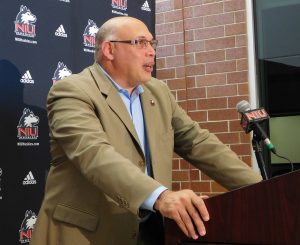A new home for the Huskies? NIU among institutions vying for spots in Big 12 expansion
Jack McCarthy — August 16, 2016
Northern Illinois athletic director Sean Frazier talks about Northern Illinois football and other sports during the Huskies’ DeKalb media day last week. (Photo by Jack McCarthy / Chronicle Media)
Sean Frazier says Northern Illinois University loves being in the Mid-American Conference.
But if the Big 12 Conference comes calling, then the Huskies athletic director says his institution’s “body of work” merits a strong look as a potential member.
“We’re really focused on the MAC, I have to say that on several levels because I believe it,” said Frazier during a media gathering last week previewing Huskies fall sports. “But we’ve put ourselves in a situation where we should be talked about, there’s no question in my mind. Our body of work — especially over the last 10 years in football — is pretty damn phenomenal.”
The Big 12 is considering expanding from it current 10 members to 12 or even 14 and Northern Illinois could be an intriguing addition.
Current Big 12 membership includes: Baylor, Iowa State, Kansas, Kansas State, Oklahoma, Oklahoma State, Texas Christian, Texas, Texas Tech and West Virginia.
ESPN’s Brett McMurphy reported last week that the Big 12 plans to conduct a video conference on potential membership with as many as 17 schools — including Northern Illinois.
The report said final candidates could be considered by the league’s board of directors in October.
Big 12 membership would instantly propel Northern Illinois into into the top tier of college sports, joining institutions that make up the so-called Power Five conferences that garner the most attention, money and prestige.
According to ESPN, the Big 12 has five key criteria for consideration of potential candidates: access to media markets, competitiveness of athletic programs, academic standards, fan bases, and overall reputations.
Northern Illinois stacks up favorably in some areas, less so in others.
Adding NIU would place a Big 12 outpost in the heart of Big Ten country and broaden the conference’s footprint to include exposure in a Chicago television market exceeded only in size by New York and Los Angeles.
The Chicago television universe consists of nearly 3.5 million households, more than 1 million greater than Houston and home of another potential Big 12 entrant — the University of Houston.
NIU has also made several attempts to tap into Chicago, with past football games at Soldier Field against Big Ten foes as well as trips to Northwestern for non-conference games.
In November, the Huskies are scheduled to play MAC rival Toledo at U.S. Cellular Field, the first football game ever at the home of the Chicago White Sox baseball team.
“It’s really important for us to have a base in Chicago,” Frazier said. “No one owns Chicago. I think folks want to believe they can own Chicago from a fan base standpoint. But it’s a pro town. …Football gives us an opportunity. We have a great brand, it’s been solidified and we have great competition that wants to play us in Chicagoland because of the recruiting, both basketball and football.”
Football has been a prime driver in other recent conference shakeups as that sport draws the most interest, TV ratings and revenue.
Northern Illinois made its biggest splash on the national scene in football with a 2013 Orange Bowl appearance, the first and only MAC school to play in a major college bowl game.
They also had their first Heisman Trophy finalist in former quarterback Jordan Lynch, who drew considerable attention with eye-popping passing and rushing performances between 2010-13.
And the Huskies have also been consistent winners with six straight MAC championship game appearances — including three wins — and eight consecutive bowl games.
But drawbacks include facilities, perceived lack of interest and inconsistent performances in other sports.
Huskie Stadium seats a maximum of 24,000, the smallest among the 17 potential candidates. Frazier announced a plan to expand the arena to 42,000 as part of a $138 million facilities expansion plan announced in 2014.
But the trick has always been how to fill it.
Getting fans to come out to football games has perplexed athletic officials since the 1970s. Huskie Stadium sellouts have been rare and student interest has often been indifferent.
The Dallas Morning News said NIU’s average attendance is ninth lowest among NCAA schools. CBS Sports said the Huskies averaged 13,631 fans at home in 2015.
Chicago media interest has also waxed and waned over the years, although Huskie football games are generally available on television and NIU has had some major exposure in recent years on ESPN and ABC.
“I think where we are now, looking at sports across the board, you take a look at some of the resources and our alumni engagement and some of the things quite frankly traditionally that need to happen for sustainability for any jump of conference, we need to do some work there,” Frazier said.
“We need to make sure we can proudly say we’ve done everything we can, now let’s take it to the next level where ever that might be.”
The MAC has been a comfortable home for Northern Illinois, with like-minded and similar size public institutions.
NIU joined the MAC in 1973, departed in an ill-fated attempt to be an NCAA Division I independent from 1986-92, briefly played in the Big West from 1993-95 and went independent again in 1996 before rejoining the MAC in 1997.







